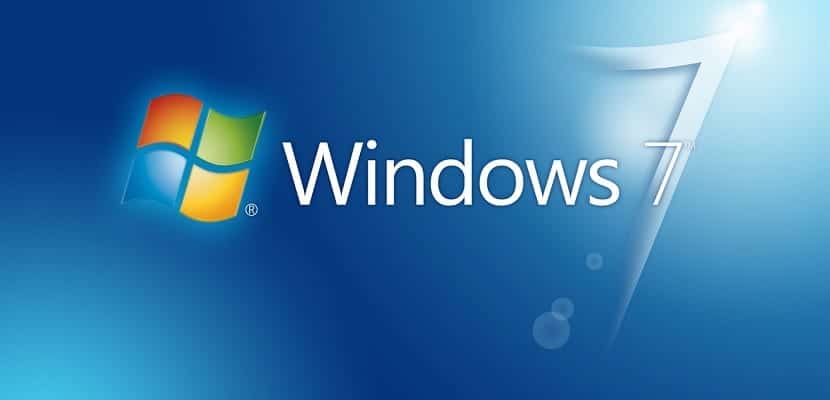
Windows 10 It has been available in the market since last July 29 and although it is having a great reception in the market, having already installed in more than 50 million devices according to unofficial figures, there may be some user who is not entirely satisfied with the new Microsoft operating system. Among these reasons may be the lack of some drivers that make the new software very difficult to use or the lack of adaptation to the new operating system environment.
If your desire is to return to Windows 8.1 or Windows 7, the two versions of Windows from which you can update to Windows 10 for free, the process is not too complicated, and in this article we are going to show you how to get it quickly, easily and when inopportune problems arise.
First method: uninstall Windows 10 from settings
Microsoft knows that Windows 10, although they firmly believe that it is the best Windows in history, may not like some user and therefore has decided make it very easy for us to return to the previous version of Windows from which we have made the leap to the latest software from the Redmond company.
First of all, it is essential to say that this method only works for all those who have updated to Windows 10 and not for those who have done a "clean installation" of Windows 10.
To return to Windows 8.1 or Windows 7 you must follow the following steps:
- Open the System Settings. To do this you must go to Start and click on the option Configuration
- Access the Update and security section. Within it we must go to Recovery
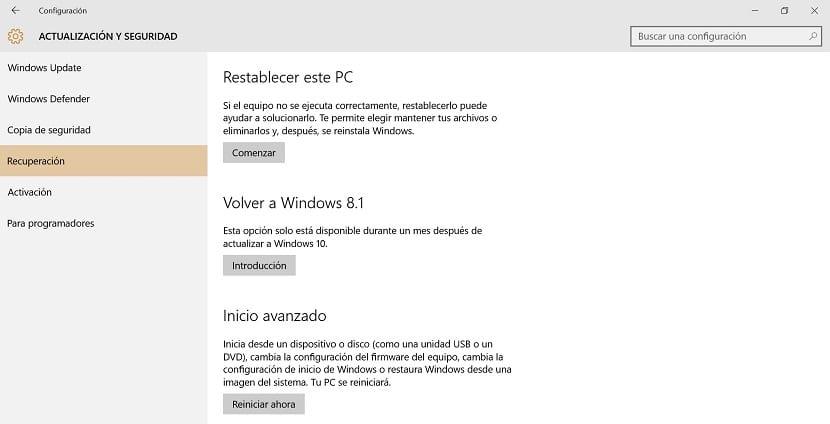
- In the event that we have upgraded to Windows 10 from a previous version of the operating system (Windows 7 or Windows 8.1) we should see an option whose title will be Return to Windows 8.1 / 7
- Press on the button "Start" to leave Windows 10 and return to your previous operating system
- Before the process begins, Microsoft will ask us the reason why we want to abandon Windows 10 and will also give us several warnings
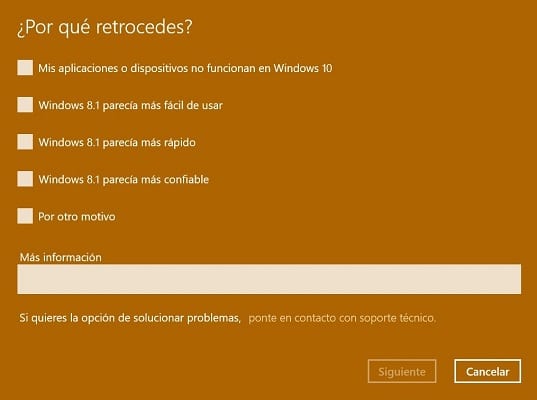
- The Redmond-based company will also remind us how cool it can be to have all of our data backed up in case something goes wrong.
- Finally, we must click on the Return to Windows 8.1 / 7 button and get comfortable waiting for the device to do the necessary work. This process can take from a few minutes to several hours depending on the configuration of each device.
How long is this method available?
Fortunately or rather unfortunately this method is only available for 30 days after the date we upgrade to Windows 10, so if after those 30 days you regret your move to the new Microsoft operating system, you will no longer be able to return to your old version by this simple method.
After this date, all the files (about 20 GB) that facilitate this return will be deleted from your hard drive, so it will be totally irreversible no matter how much you look for a way to make this method work 30 days after the update.
Second method: install Windows 8.1 or Windows 7 cleanly
The second method and also the most complicated option to return from Windows 10 to Windows 8.1 or Windows 7 is to perform a clean installation. This method should be used in the event that the first one is not available or we have installed the new Microsoft operating system using a process other than the update process, since in that case it will not give us the possibility of going back after one way. automatic restore.
Before launching into the adventure of installing Windows 8.1 or Windows 7 we must carry out some preliminary steps that we show you below:
Make a backup
Before making the leap, backwards, from Windows 10 to a previous operating system, we must make a backup copy of all the files on our device. You may have the option to do it before installing the new operating system, so you should assess whether it is necessary to do it again or not.
In order to make this backup you must go to Settings and then access the Update and security option. There we will find the Backup option, where we must select the Add drive button.

Depending on the operating system to which we want to return, we must bear in mind that to appear to be a backup compatible with Windows 7 it will be necessary to do the same process that we have already mentioned, but at the end of it select the option Go to backups and restoration (Windows 7).
Get a DVD or USB drive
One of the points that complicate the clean installation of Windows 7 or Windows 8.1 is the get an installation DVD or USB drive for either of these two operating systems. Of course we are talking about a legal copy.
In the event that we do not have an installation disc, from the Microsoft website we can download the necessary installation files, in a completely legal way. You can access the Microsoft download page from this link.
Once we access the page we must download the version of Windows that we need, although it is important to bear in mind that with Windows 7 Microsoft will require a valid product key. You can use the one you already had from your PC or use another key that you have obtained by other means. We will choose if we want to download the 64 or 32-bit version and now we will only have to wait for the download to finish.
How do I know if I have to download the 64-bit or 32-bit version?
To know if we must download the 64 or 32-bit version, it will be enough for us to access the Configuration of our device and there we select the System option. Once in this section we must click on the section titled About and finally on System Type. There we can know if the version we are currently using is 64 or 32 bits.
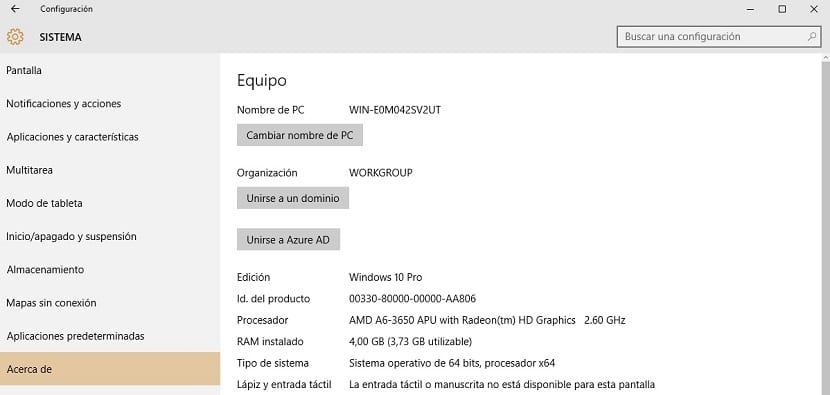
Once the ISO we want is downloaded, the problems come and we must "burn" that ISO on a DVD for which Microsoft gives us the option directly or save it on USB, something much more convenient.
To be able to choose this last option, we must download the following tool with which we can quickly and easily create an installation USB with which to cleanly install the new version of Windows that we have chosen.
If we choose Windows 8.1 as the new return point, everything will be easier and that is Microsoft does not offer us the ISO of the software but rather offers us a tool called Media Tool Creator that allows us to directly create a DVD or USB to install this operating system.
We start the installation
If you already have a backup copy of all the data on your device and you also already have the installation DVD or USB for the operating system you want to install, it is time to begin the installation.
First of all we must insert the DVD or USB into the corresponding place and restart the device, making sure that it will start from the unit where we have inserted the new software. If this does not happen, the device will reboot into Windows 10 again without us being able to start the installation.
From this moment on, you must carefully follow all the instructions that the installation assistant tells us, which does not usually pose any problem to anyone.
Third method: restore operating system settings
The latest Windows 10 uninstall method may be the least known of all, but it's also one of the easiest. We are talking about the option to restore the factory settings of our device, which will allow us to return to the operating system that the device had installed the first time we started it. In addition, it will recover all the benefits of performance, storage space and many other aspects that the device had the first day we turned it on.
To restore our device we must bear in mind that a clean installation of Windows 10 cannot have been carried out because we will have Windows 10 again, only with the device completely clean and without any problems. If we have updated to the new Microsoft software from a build preview, this method will not help us either.
To restore your computer you must follow the following steps;
- Go to Configuration and once there select the option Update and security
- Choose the option Recovery and press the Start button within the Reset this PC section
Now the operating system will show us the option to keep the files, remove everything or restore the factory settings. The option to select is the last one because otherwise the restoration will occur, but we will continue in Windows 10.
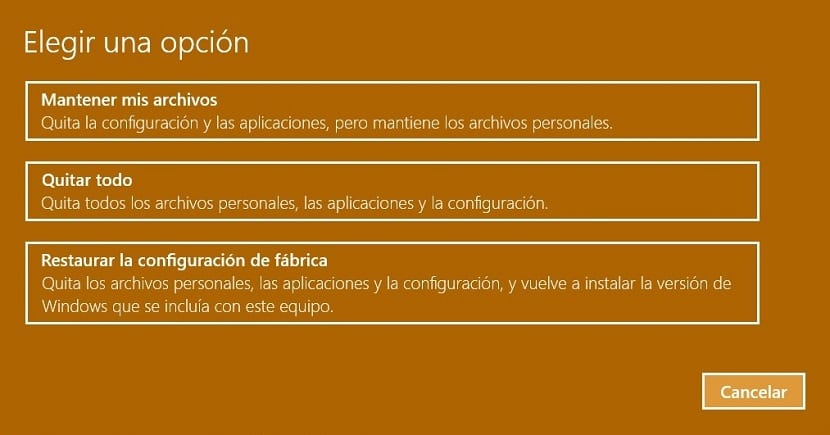
Have you managed to uninstall Windows 10 successfully?. If the answer is affirmative, we would be delighted if you would tell us how you have done it and especially because you have decided to abandon Windows 10. You can tell us using the space reserved for comments on this post or through any of the social networks in which we are present.
ok, and if it doesn't give me the option within the settings to go back to Windows 8.1, how do I have to go back?
Very good!
With the second method. Of course, if you have updated from W8.1, the option should appear.
A greeting.
I changed to Win 10 but the audio drivers do not work, and when I want to go to the technical support page I get an error, what do I do?